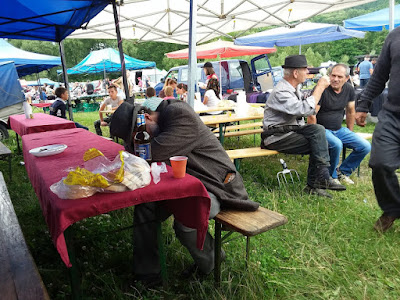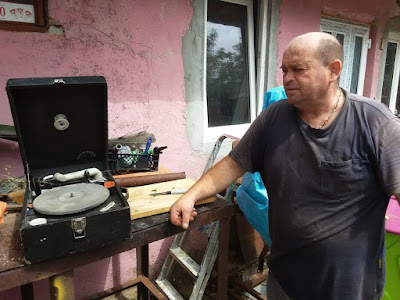So last week I was tooling around Northern Romania with Mitia Kramtsov, Mitia is the fiddler and lead singer for the Russian klezmer band Dobranotch, based in Sankt Petersburg, and we met some years ago while we were both teaching fiddle at Klez Kanada, and we clicked. Ahh.. we are the scratchy fiddlers... the neo-geezers... the ones who failed the conservatory entrance exam and sit in the back smoking reefer with the tuba players... And this all happened during a historic event involving our two countries. Just as Vladimir and Donnie were trading secrets in Helsinki, Mitia and I traded fiddle tunes in a farmhouse in Ieud. And for ten days we did not talk single word about any politics at all. We were Jewish fiddlers on a mission: to find fiddlers in Maramures. Old style fiddlers. Geezers, really.
 |
| The ""Happy Cemetery in Sapanta |
| Nicolae and Viiktor Covaci |
Nicolae is gone now but his half brother Viktor is alive and kicking and living down the street, so we spent the afternoon with him enjoying tunes at the village bar. Viktor knows a lot of the older style tunes, but without Nicolae as lead fiddler, those rare Yiddish melodies don't come to mind readily. Viktor is about 72, but he plays like his older brothers did - the rock steady rhythm and simple lines of the older, less ornamented Romanian mountain style of Maramures. Think of it as American old time Appalachian fiddle versus bluegrass fiddle.
 |
| Don't miss the food court at the Dragomiresti Plaza! |
| You won't find these babies on Zappos.com |
In Maramures all fiddle matters lead to Ioan Pop, the leader of the Iza group and one of the most sought after wedding performers in the region. Ioan is a leading traditionalist - he lives as a peasant farmer during the week and plays weddings on the weekend. (He has wedding gigs every single day of the week this August.) We caught him at home in Hoteni after a 23 hour gig, but he was still up for some tunes. I asked Ioan who was left playing the old style Maramures fiddle? "You and me" he said.
 |
| Ioan Pop at home with "vioara cu goarne" |
Marius is one of the last makers of vioara cu goarne - there are a few more, but it is getting increasingly hard to find the materials to make the fiddle. The resonators are home made - the frame being from auto parts and the resonator disc is made from various sheet metal. Dorel used mica for some of his and Coca Cola cans for most of the others, while Mircea Rostas used beer cans but then decided that metal discs cut from cans of energy drinks such as Red Bull was, naturally, more energetic. Marius used special alloy sheet metals and actually tunes his resonators.
The resonator attaches to the foot of the bridge via a mechanism cannibalized from the tone arm of an old gramophone record player - you know, the wind up kind that plays 78 RPM records? Sourcing old 78 record players is the hardest part of maintaining the vioara making tradition. Marius makes his deluxe models using old Czech Supraphone gramophone record players that he orders on ebay.
The difference is mainly in the richer sound and louder volume of the Supraphone resonator fiddles. All of these fiddles are loud - but the Supraphone resonator really makes a difference. Marius' Supraphone fiddles are pricier than his simple fiddles, but local fiddlers, especially the ones who play professionally at weddings, prefer these. Like many metal resonator instruments, its a mystery only the player can relate to. I play old fashioned blues guitar on a Style O resonator guitar made by the Johnson company (marketed today under the Recording King trademark) and if you compare it to a new American made National Guitar style O... you'll want the National.... if you have the significantly extra cash, which I do not. As it is, I get a resonator sound only slightly less loud than the national.
I had not planned on traipsing around the back end of Oradea last week, but I am really glad I did. As European vacations go, it was unique - "Hey! We're off to fabulous Oradea for our summer holidays!" is not something you will hear at many office water coolers. We had a great time with Marius, who was a generous host and showed us around his workshop, even smelting a couple of resonators fresh for Mitia. Mitia bought a great fiddle. I don't personally sell these instruments - and I get a lot of mail from folks who want one. If you do ask me, I can send you a contact for Marius - his sister speaks English and handles his email and they have shipped these abroad. And now... Mitia Kramtsov himself:

